It’s been cold. On many nights, the needle on the outside thermometer has dipped well below 0°F. Daytime temps rise only into the low teens. I’ve written about cold weather care for chickens here and here. I’ve followed my own advice of don’t worry and keep things dry and give them a little extra feed. I have well-designed coops, and that makes all the difference in how the hens fare in this bitter cold.
The one thing that I do is to keep an eye out for frostbite. Surprisingly, chickens can walk around on ice and snow and not show any pain or signs of freezing in their feet. However, their combs will succumb. Frostbite can cause pain. It can reduce a rooster’s fertility and stop hens from laying. You’ll know severe frostbite when the tips of the comb turn black. They might even fall off.
I don’t worry about that with Veronica. She’s a Cuckoo Marans, which is a winter-hardy breed. Not only does she have an extra layer of soft feathers under her harder, water repellent outer feathers, but she also has a tight, low comb. She’s not going to get frostbite, no matter what Old Man Winter throws at her.
Nancy Drew is not a winter hardy breed. She’s a Black Star – a hybrid designed for laying. She has an upright, medium-sized comb. But, the cold hasn’t stopped her. She’s consistently laid an egg every other day. However, her comb is a duller red than the bright flame of summer.
I’ve kept a close eye on Twiggy. Leghorns are not winter hardy. They don’t have downy undercoats for warmth.
They have ridiculously large and floppy combs which are useful for dissipating heat in the summer, but prone to frostbite in the winter. Twiggy’s comb has a bit of a grey cast to it, but is otherwise fine.
Smearing vaseline on the comb might protect it from frostbite. The petroleum jelly keeps water off of the comb itself, and therefore makes it less prone to freezing. My hens, in their dry coops, don’t have wet combs, and besides, rubbing vaseline on a hen is a messy, difficult job. Additionally, the hens that would benefit are the ones that don’t like handling. So far, I haven’t bothered.
The cold has not stopped Twiggy from laying her daily egg. The other morning it was -5°, and I saw her hop into the nesting box to do her job. She is also the first one outside in the morning. I suspect that if she was in weather like they have in Montana, down to 20 below, that the cold would be too much for her. But, here in frigid New England, Twiggy is doing fine.
However, the cold has been hard on Misty’s comb. Like the Twiggy, she’s a Mediterranean breed, sleek and with a large comb. She’s a flighty, nervous girl, so she’s not going to sit still in a warm patch of sun. Her comb, which looks like this in the summer
has shrunk down to a grey ridge.
Misty shows no sign of distress or pain, and there are no blackened dead spots. Will it plump up again in the summer? I don’t know. Will Veronica ever lay an egg? I don’t know that either.
I do know that all of the hens are behaving normally. The ones that lay, do. The flock goes outside for exercise and sunshine. This frigid polar weather isn’t getting them down.
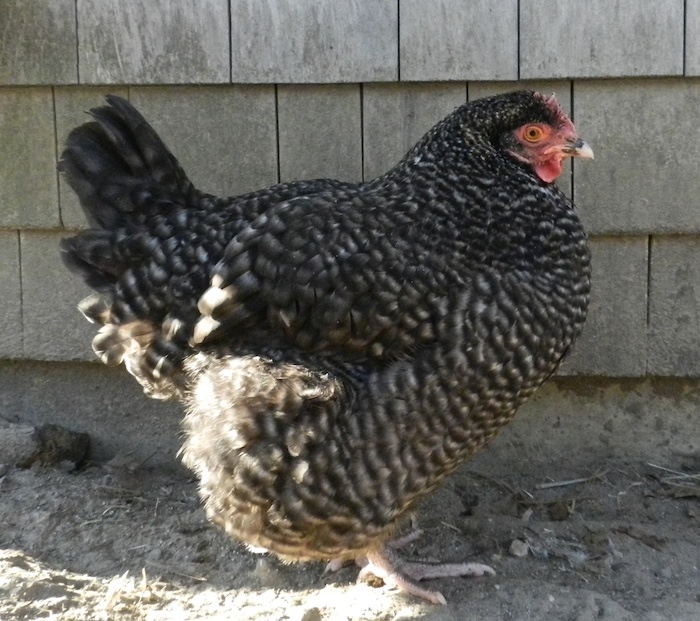
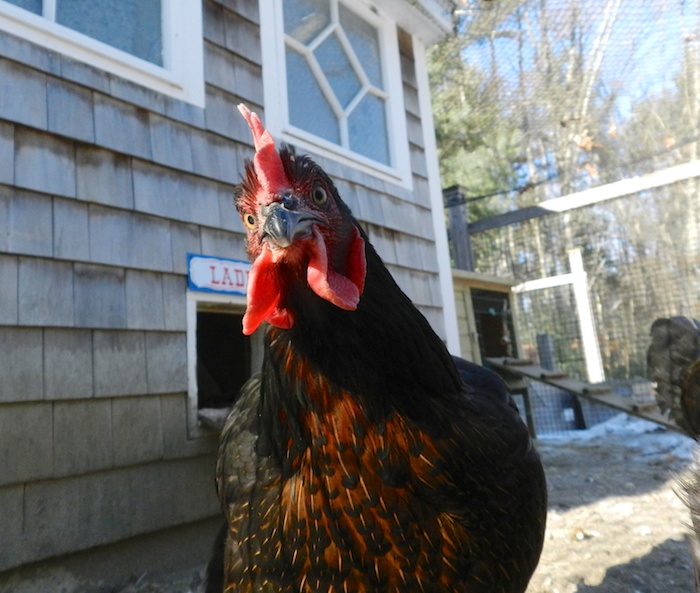
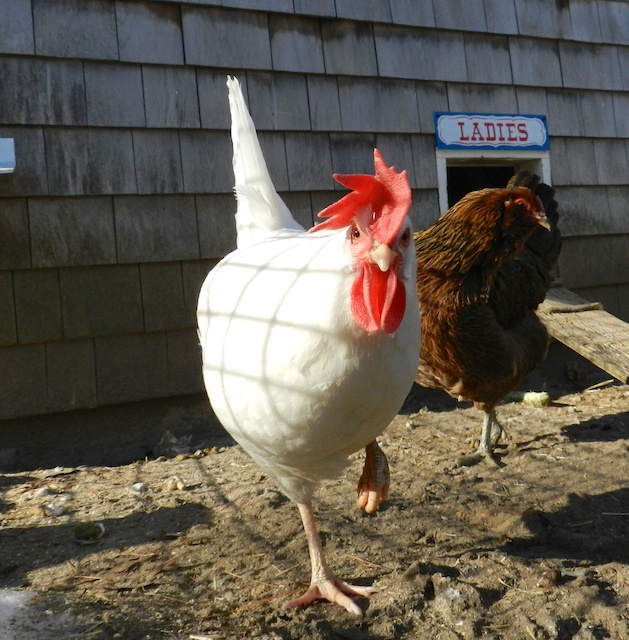
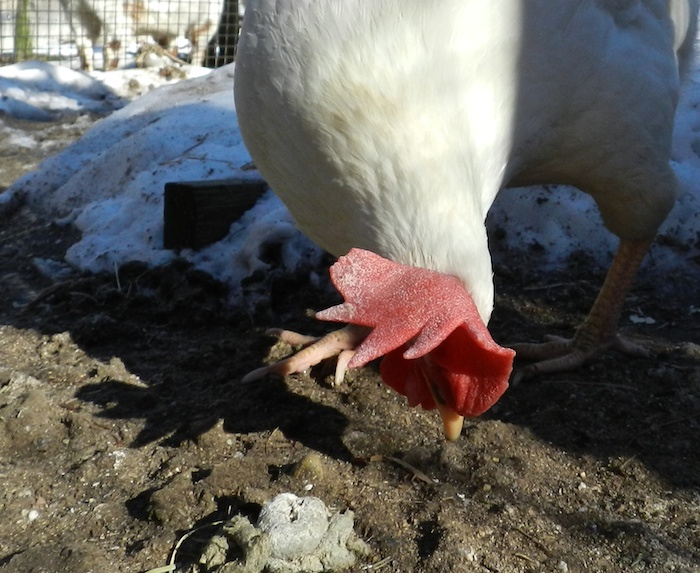
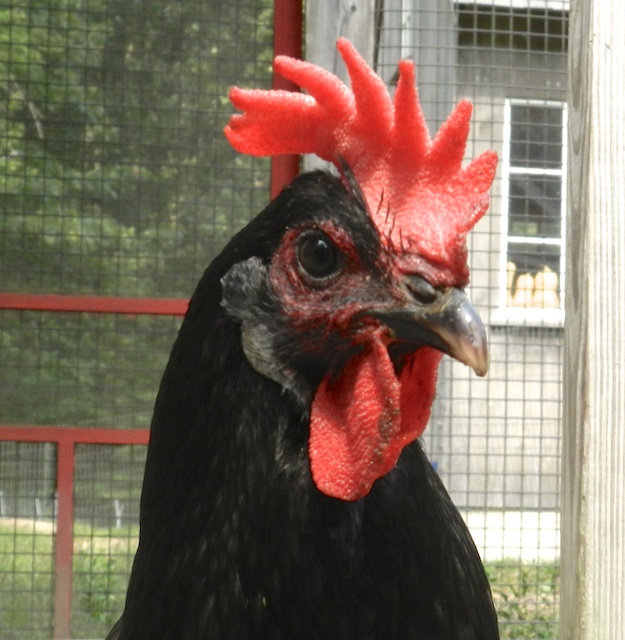
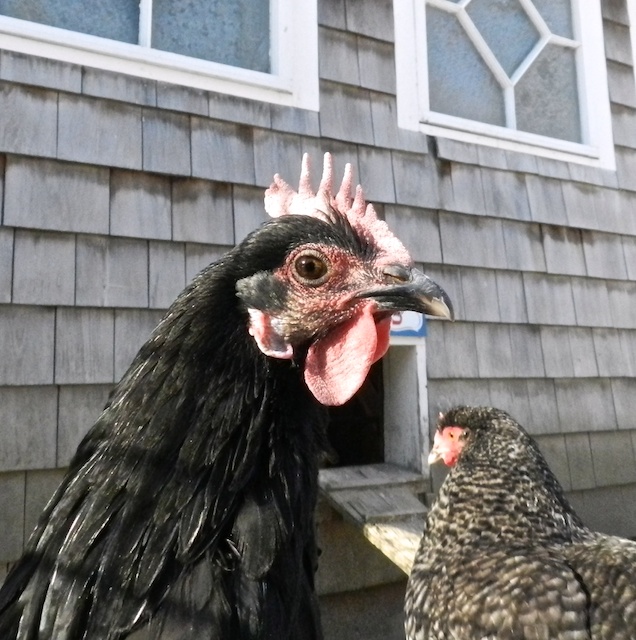

Thanks for that – my CA White has got a couple of black tips – it happened early in the season when I wasn’t paying as close attention as I should have to humidity in the girls coop. Lesson learned unfortunately for Ethel. Now I have a temp/humidity thingamado that I can see remotely so I can keep an eye on the humidity and ding around the vents in the coop and keep moisture at bay.
Sadly, I have my Welsummer in the basement because her comb got frostbit. I kept an eye on her but with our temperatures in WI getting in the double digits below 0 and much lower with the wind chill when they go outside, it didn’t take long. None of my other hens had a problem, including a black star with a nice big comb. My Welsummer is eating and behaving normally so I hope she’s not in pain- but a few blisters developed. I swabbed the comb with betadyne to prevent infection should the blisters burst. The thing is, for some reason this bird started her molt about 3 weeks ago. Not sure why she waited so long but now that the temperatures are getting closer to just plain old freezing I’ll be taking her outside again and watching her closely. Always something…. I bet Misty’s comb will plump up in spring. What three, four months from now???
Hens will molt when stressed, and I’m sure it was the frostbite that stressed her. As soon as you can, get her back out with the flock. The sooner you can, the easier her transition back into the pecking order.
My opinion on Twiggy is that she has a dry comb. As humans our skin dries out in the winter dryness and I think the same thing can happens to chickens combs.
I believe Misty’s comb will return to it’s summer glory once the weather warms up and she starts laying regularly.
And yes Terry lathering Vaseline on combs and wattles is a messy business (it’s also a great cure for scaley leg mites). I speak from experience. I’ve walked out of the coop after treating for scaley let mites with more feathers on me than some of the chickens. ;-)
I’ve used it on legs, too. Effective for them, a mess for us!
Since Thanksgiving I have put vaseline on my 4 pet roosters twice, and Triple Anti-biotic cream on twice. These are 10 month old very large, but tame roosters. Other than the grease on my hand, they love it, and I don’t have a problem applying it. Don’t panic if you see some black, because it is sometimes from pecking. I am seeing a greying, and some white, which I hope will be ok. It may be the ointment! Surprisingly the cuckoo marans rooster and the speckled sussex rooster have the largest combs and wattles, but look good. the 2 Faverolle roosters have no wattles, and have shorter but pointier combs, and they are the ones that look bad. We have had temperatures as low as negative 9 degrees, here in Springfield, MO. I have nice buildings for my chickens, but they are metal sided. I did see frost inside of the walls where the roosters are. The chicken house has a glass window, so no problems, and both houses have insulated roofs. The last time that I applied the ointment the poor things were so cold and stiff, until I rubbed the medicine on. Yesterday I picked each of them up and they all felt soft and warm. I hope they will not lose their beautiful combs. They don’t seem to hurt. If you are able to pick up your chicken without a problem, don’t be afraid to put on ointment. I get the ointment on one hand prior to catching the chicken, then I catch the chicken. Mine are used to being picked up. Take your hand directly to their comb, don’t have your hand out in front, or they will peck, out of curiosity! It seems to be like your spa treatment, they like it!
I have been applying calendula cream to thier combs on the freezing nights. I wont use vaseline as it is a petroleum product and I prefer natural organic methods. I heard coconut oil will work also. So far so good, but they put up a stink when I do it.
Awww, poor Misty, Her summer photo is just gorgeous! I hope her comb and wattles will return!
I love that picture of Twiggy posing for the camera!
Terry, I was worried about respiratory ilnesses with my poor coop design, but the issue that I was least worried about popped up. Frostbite. My rooster (golden sebright; not cold hardy) got some mild frostbite on the “tail” of his comb, and some severe, black tips on the sides (only two very small spots). He’s okay, and the temperature is now in the 40’s and tomorrow will be in the 50’s!
I’ve been hearing a lot about frostbite in poorly ventilated, damp and too small coops. Sorry about your Seabright!
Fortunately I have not had to deal with frostbite in decades. But back in the late ’80’s when we had some brutal winters frostbite was a problem for me.
Mikayla my advice is to watch when the black dead tissue falls off. Treat with an antibiotic cream to help prevent infection.
Thanks to both of you!
This is most likely a very old fashioned thing to do but they still do it here in Lancaster pa on the Amish farms and this is how we always did it. For frost bite we washed the combs with warm milk and applied linseed oil.
Wow, extreme cold and frostbite are wicked stuff. Fortunately, my hens haven’t had to deal with that here in FL. It was down to 33 earlier this week which they handled just fine. Cold weather doesn’t last long. Looking for to seeing spring in your area and watching your hens thaw out. I’m sure spring is beautiful! =)
A few years back I found this:
http://www.ksre.ksu.edu/historicpublications/pubs/SC093.pdf
Culling Farm Poultry 1922
I’ve used it since for culling for layers. In it, it described how comb condition was co-related to egg tract condition. There are even photos.
I’ve found it to be spot-on with my various flocks.
Regarding frostbite, toes can be frost bitten, especially if roosts are round poles, or anything the birds have to wrap their toes around to stay on. We used the large flat side of 2″ x 4″ s when we built the coop, because we have -25F temps here. The benefit is that the toes are under feathers, which protects them, but also help with heat loss. Every little bit helps and might mean the difference between survive and thrive in cold winters. (They are also very easy to clean with a hand sander.)
Many of those old brochures are useful. As far as round vs. flat roosts- the debate goes on. I prefer the round roosts. Being able to wrap their feet around the roost gives them stability when sleeping. My girls hunker down and I don’t see anything other than the toenails.
Terry, I have three Hamburgs. Their combs shrink and fade and stop laying each winter but the combs return bright red in the spring and begin to lay again, at least they have the past four years.
I hope that’s what Misty’s comb does.
I find it so hard to comprehend such winter temperatures. And here I was worrying about whether I will need to purchase a heat lamp for chicks overnight if temperatures went down to 20 degrees celsius indoors (I think that’s about 68 deg fahrenheit). Frostbite too? My goodness, I simply cannot imagine it. I’m in Australia so I guess that explains a lot :)
And I can’t fathom the furnace that makes up most of your country!
Yes that’s about right too Terry! Especially with widespread heat waves at the moment although thankfully we have escaped such awful heat where I live.
We are concerned again, bitter cold, down to zero, more dry snow, extreme wind, and I am in southeastern Mass. I have 45 hens, from 4 and a half to 5 months. Our set up is a shed solid wood built during the summer 8×10, a small chicken coop solid wood, holds about 9 hens, a 9 foot long f foot deep hutch that was used for rabbits and chickens. The hutches have plenty of straw for the hens, the coops have shavings, and roosting bars.
I am going to attempt to get all the hens into the 8×10 shed, Wed afternoon, ones that I cannot get in, I will give them water and food in the hutches Wednesay morning, as the storm is predicted to begin later Tuesay afternoon.
We had same weather about three weeks ago, I was able to get many hens in the new shed, then, next morning while hens were still drowsy,said hens that were in the small coop and hutches I moved them to the new shed.
I put food and water in the shed, checked on hens numerous times, very careful not to step on eggs, hopefuly, I will be able to do the same tomorrow afternoon and Wednesday morning.
Oh, I have four leghorns 4 months old, I am very concerned about the leghorns, last storm, I was able to ut them in the new shed before daybreak. Hens were in the shed for several days.
For twenty years I have kept hens in uninsulated coops and I have never had a death due to cold. Putting a lot of hens together, that don’t know each other, into crowded conditions will cause more harm than good. However, your birds are quite young. This is why I don’t recommend getting chicks in the fall. If they’re not fully feathered out, they’ll need heat. You also mention eggs on the ground. Hopefully, you have nesting boxes that they can learn to lay their eggs in. Lots to think about with a flock!